
DoD applications in small mountain basins: insights from the Gadria basin (Italy)
Felix Pitscheider1, Francesco Comiti1, Joshua Theule2, Bernhard Gems3 & Marco Cavalli4
1,Free University of Bozen-Bolzano, Faculty of Science and Technology, Bozen-Bolzano, Italy.
2,TerrAlp Consulting, St Martin d'Uriage, France.
3,University of Innsbruck, Unit of Hydraulic Engineering, Innsbruck, Austria.
4,National Research Council (CNR), Research Institute for Geo-Hydrological Protection (IRPI), Padova, Italy.
Corresponding author e-mail: felix.pitscheider@hotmail.com
DOI: https://doi.org/10.3301/ROL.2022.19
Volume: 58/2022
Pages: 34-41
Abstract
This study analyses three high-resolution DEMs (1 m resolution) derived from ALS data collected in 2011, 2018, and 2020 in the Gadria basin (South Tyrol, Italy) to assess topographic changes and estimate their volumes in a debris-flow catchment. Sediment budgeting was performed in a selected Sediment Contributing Area (SCA). Additionally, a highly active area in the headwaters of the catchment was surveyed by aerial photographs in 2016, 2017, 2019, and 2020 (0.20 m resolution), which were then analysed through Structure from Motion (SfM) technique. The suitability for sediment budget analyses was assessed for both methods and results show that both the ALS- and photogrammetry-derived DoDs are appropriate when all the multiple sources of error are fully taken into account in every step of the DoD derivation. In general terms, topographic data derived from ALS surveys may be sufficient for catchment-scale (>2-3 km2) DoD analyses, whereas higher resolution data from SfM could be needed for analysing smaller area of interest.
Keywords
Get Full Text